Many arborists & landscapers often find it difficult to prevent white pine weevil pests (Pissodes strobi), because they are typically applying fertilizer & dormant oil treatments during the control window. In the state of NJ, the control window against feeding white pine weevil adults occurs in March & April. Adults over-winter in the duff beneath trees. The WPW adults will often crawl or sometimes fly to the top terminal leaders of pine, spruce, or Douglas-fir trees. Eastern white pine & Norway spruce species are the most severely attacked & the death of the terminal leaders of these trees will often occur.
Treatment timing is critical with this pest and controlling the adult female before egg laying is necessary. Apply preventative sprays (e.g., pyrethroids) only to the terminal leaders during this time. Before mating & egg laying, adults will feed by chewing holes within the central leader & cause a characteristic pitch flow that becomes white in color when dry. Then females will lay eggs in new cut-out holes within the top 12 inches of the leader just below the terminal bud. This blog will describe with the help of photographs the 7-stage lifecycle of this native weevil borer. Control & management options will also be provided.
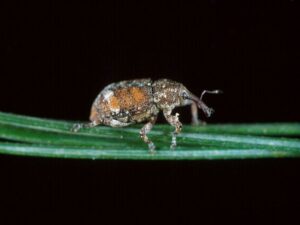
White pine weevil adults are about 1/4+ inch long & have a long snout with two white spots on back of wing covers. Adults feed at terminal leaders during March & April. Most eggs will then be laid during April & May. (Photo Credit: Michigan State University)
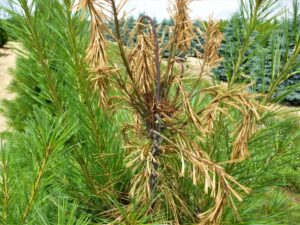
Severe white pine weevil infestations to terminal leaders can destroy two or more years worth of growth to pine, spruce, & Douglas-fir trees. (Photo Credit: Steven K. Rettke, Rutgers Coop. Ext.)
Life-Cycle Overview:
Eggs:
The white pine weevil pest (Pissodes strobi) has only one larval generation per year. In NJ, the overwintering adults can be active from mid-March into the summer months. After adults feed for a couple of weeks, oviposition can begin as early as the first week of April & can continue until early June. Eggs are laid in saucer-like cuts in last year’s leader within 12 inches below the terminal bud. Unlike feeding wounds, these cuts do not usually cause any pitch flow. Egg-hatching will occur 1-2 weeks later & with the extended egg-laying duration, can continue to hatch from mid-April into the month of June. Females will lay an average of 100 eggs & it is not unusual for 2 or 3 mating pairs to infest a single leader.
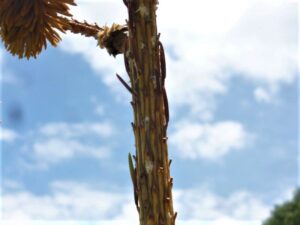
White pine weevil adults will feed within the upper terminal leaders & cause pitch flow that when dries has a white appearance. This is an early symptom that adults are active & control materials need to be applied. When eggs are laid the resin flow does not typically occur. (Photo Credit: Steven K. Rettke, Rutgers Coop. Ext.)
Larvae:
When the terminal leader is heavily infested, potentially a few hundred larvae can initially compete for food in a single stem. As food becomes less available many larvae will not survive to become adults. The larvae feed side by side in a ring encircling the stem. They tunnel in a downward direction as they burrow just under the bark feeding within & destroying the vascular tissues. The larvae that survive will molt four times during a 5-6-week period before pupating & becoming adults. Late instar larvae can reach the size of 1/3rd to 2/5ths of an inch. In our region, depending on when they hatch, larvae could be active from mid-April to early August.
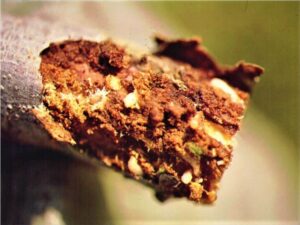
A handful of young larvae feeding along only a one-inch section of the terminal leader. (Photo Credit: Steven K. Rettke, Rutgers Coop. Ext.)
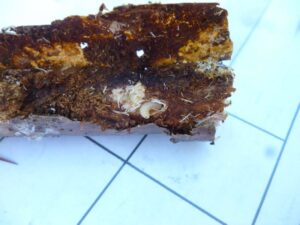
A mid to late instar larva with extensive frass evident. Extreme damage to the vascular tissues is obvious just beneath the bark. (Photo Credit: Steven K. Rettke, Rutgers Coop. Ext.)
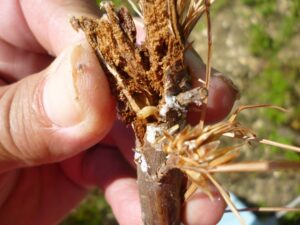
This late instar WPW larva has probably completed its 4th molt & has caused extreme damage within the vascular tissues of the terminal leader. The 4th instar stage can reach 2/5ths of an inch in length. (Photo Credit: Steven K. Rettke, Rutgers Coop. Ext.)
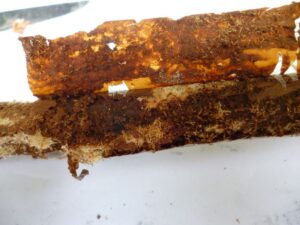
With the outer bark peeled away, the extensive frass & feeding damage is easily observed. (Photo Credit: Steven K. Rettke, Rutgers Coop. Ext.)
Symptoms:
The early feeding symptoms of the larvae will cause a “shepherd’s crook” in the new terminal growth. The new candle growth is capable of extending during the spring months, but by early summer the feeding larvae will have destroyed much of the water-conducting tissues in the previous year’s leader. As the weeks of summer continue the symptoms become more severe. The terminal leader will become stunted and wilted with the needles turning brown. Eventually, as a result, the new or current year’s leader & lateral growths will be killed without the larvae ever directly feeding within them. Sometimes larvae can tunnel past last year’s whorl of lateral branches & feed in the terminal leader from 2-years ago. Therefore, this could effectively result in 3 years of lost growth.
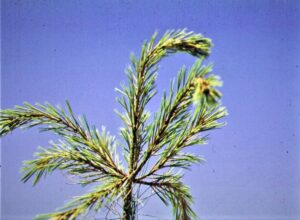
In June, another early feeding symptom will be the so-called “shepherd’s crook.” The new terminal leader growth is showing the downward bend of the upper tip as moisture stress begins to occur. (Photo Credit: Steven K. Rettke, Rutgers Coop. Ext.)
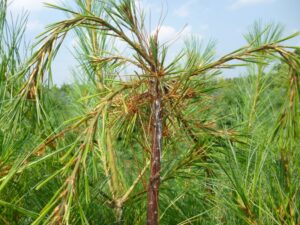
As feeding larvae continue into the late weeks of spring & into the summer, more moderate symptoms appear as the new whorl of side branch laterals begin to dry, wilt, & show browning needles. (Photo Credit: Steven K. Rettke, Rutgers Coop. Ext.)
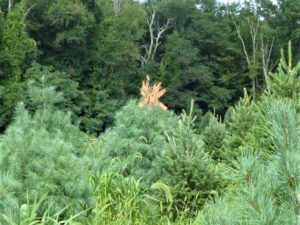
Later into the year, the feeding symptoms on dying terminals & laterals become obvious from a distance. (Photo Credit: Steven K. Rettke, Rutgers Coop. Ext.)

When infestations are more severe, then it becomes possible for multiple years growth to be damaged as weevils feed within stem leaders from 2 or even 3 years ago. (Photo Credit: Steven K. Rettke, Rutgers Coop. Ext.)
Pupation:
Near the end of the larval stage, the larvae will construct pupal cells deeper into the pith of the stem. So-called “chip cocoons” are created with numerous small strands of wood. By late spring or mid-summer, many white pine weevil larvae will pupate & will then remain inactive for 4 weeks or longer.
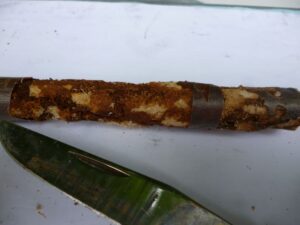
Bark is pealed away with a pocket knife & several WPW pupation cells are shown along a 3-inch section of this terminal leader. (Photo Credit: Steven K. Rettke, Rutgers Coop. Ext.)
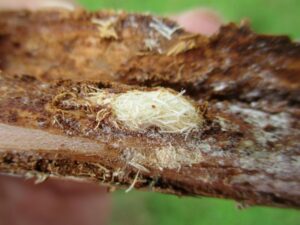
Pupal cells composed of strands of wood create the “chip cocoons.” (Photo Credit: Steven K. Rettke, Rutgers Coop. Ext.)
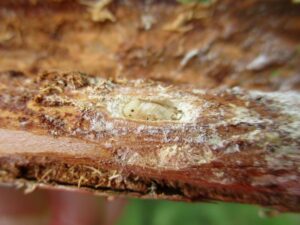
Removing the outer wood fibers reveals the actual WPW pupal stage dug-in deeply into the stem. (Photo Credit: Steven K. Rettke, Rutgers Coop. Ext.)
It is too late in the season to save the leader and it should be pruned out & removed from the site while the weevils are still in the larval or pupation stages. The infested leader(s) need to be removed before the emergence of adults. The pupation stage can occur as early as late May & could extend to the end of August.
Adults:
As adults begin emergence, they will chew small circular exit holes in the leader(s) that can be 1/8th inch in diameter. The adults are approximately 0.25 or more inches in length & are dark brown with white to tan markings. After emergence, adults will feed on bark tissues & buds of lateral branches, but little damage is done to the trees. They may also mate during this early adult period but will not lay eggs. After winter hibernation they may mate again in the early spring, however, this time egg laying will occur. During early November & with cooling temperatures, adults will drop down beneath host trees to seek shelter. They will eventually hibernate under the duff or leaf litter within a foot of the base of the tree. In various NJ areas, the hibernation period can last from mid-November to late March.
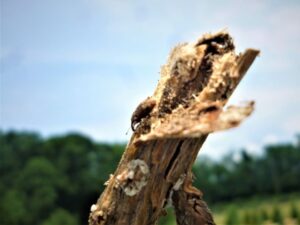
Upon the completion of the pupation stage, summer adults emerge. Although a few adults may emerge as early as the 2nd half of June, most will not be seen until July or August. (Photo Credit: Steven K. Rettke, Rutgers Coop. Ext.)
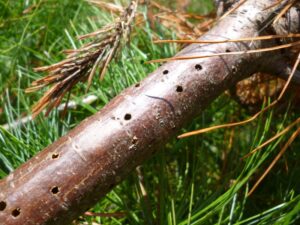
Adult emergence holes (1/8th inch) are clearly evident on the terminal leader. (Photo Credit: Steven K. Rettke, Rutgers Coop. Ext.)
| Summary of Life Cycle of White Pine Weevil (NJ Region) |
| Spring Adults = Mid-March to summer months |
| Oviposition = Early April to early June |
| Egg Hatching = 2nd week of April to mid-June |
| Larvae = Mid-April to early August |
| Pupae = Late May to early September |
| Fall Adults = Mid-June to early November |
| Hibernation = Mid-November to late March |
| (Source: U.S. Department of Agriculture: Forest Insect Leaflet 21) |
Correction of White Pine Weevil Injury:
Infested trees that are larger than 3-4 feet in size will rarely be killed by this pest. Smaller trees may lose their Christmas tree shape and/or develop multiple terminal leaders. This injury is critical within nursery production or Christmas tree farms & therefore management options are important. Within landscape settings, the injuries may be tolerated, but a flat or table-top bushy tree appearance can result. Once white pines reach a height of 20 feet or more, they are more tolerant of this pest because they naturally develop multiple leaders.
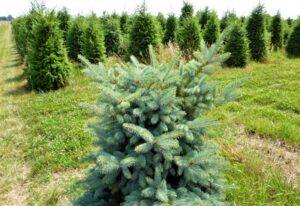
This blue spruce has lost its’ terminal leader from WPW feedings. It can cause a bushy, flat top appearance if a new dominant leader does not develop. (Photo Credit: Steven K. Rettke, Rutgers Coop. Ext.)
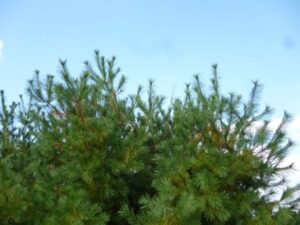
When eastern white pines reach 20 feet or more in height, then they naturally produce multiple leaders & WPW pests are less of a concern. (Photo Credit: Steven K. Rettke, Rutgers, Coop. Ext.)
To re-establish a new leader and retain the desirable Christmas tree shape the following procedures are suggested. 1) Remove the dead or dying portion of the terminal leader. Also, remember that the larvae feed primarily on the terminal growth that expanded during the previous year. Therefore, the leader growth from both last year and the present year will need to be removed. If the infestation was especially severe, then larvae may have extended past last year’s lateral whorl & down into the leader from two years ago. 2) The selection of one of the strong side lateral branches from the whorls that grew last year needs to be selected & staked to establish it as the new dominant terminal leader. To avoid laterals competing with each other to become the terminal leader & causing a forked tree, then a possible method is to remove all but one of the whorls of side branches that grew in the previous year. Some nursery and Christmas tree farms have reported good results with retaining the one side lateral branch that grows on the north side of the tree. This north lateral branch will have the natural tendency to grow upward and reach toward the southern sun.
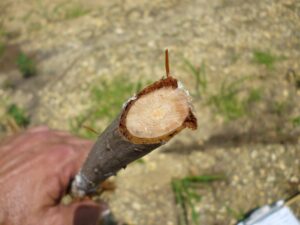
When initially cutting & removing the infested terminal leader, it is important the remaining stub is clean of feeding larvae. The cut end of this stem still shows the presence of feeding larvae just under the bark. (Photo Credit: Steven K. Rettke, Rutgers Coop. Ext.)
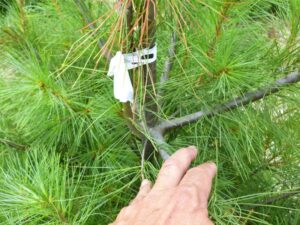
This Christmas tree grower has made the decision to train a new leader by tying & staking it to the older, previous dominant stem. Once the new leader becomes established, then the tie must be removed & the old leader cut-out as near at the top of the whorl as possible. If not removed it could act as a future point of entry for heart rot organisms. (Photo Credit: Steven K. Rettke, Rutgers Coop. Ext.)
Chemical Controls:
Chemical insecticides against white pine weevils during the spring period are only effective when adults are feeding & before females lay eggs. Arial sprays only need to be applied to cover the terminal leaders at the tops of trees. Pyrethroids sprayed on the bark can have an effective residual of up to 3-weeks. Included within this group of insecticides include bifenthrin (e.g., Onyx), permethrin (e.g., Astro) & cyfluthrin (e.g., Tempo). Since an extended egg-laying duration occurs with this pest, a second application may be recommended.
When given enough time, a preventative systemic such as imidacloprid (e.g., Merit) can be applied as a soil injection or drench during the previous fall season (October or November) to control the early spring feeding period of adults. It can also be effective against the early instar larvae. This approach may only be economically viable when a few select trees can be targeted having a history of this pest.
Overall, the best integrated controls are achieved with a combination of well timed insecticide treatments against spring feeding adults & the mechanical removal of infested terminal leaders before summer adult emergence occurs.
Reference: U.S. Dept. of Ag., Forest Insect & Disease Leaflet 21, “White Pine Weevil”, Abdul Hamid, Thomas M. Odell, & Steven Katovich, March 1995.
Reference: The Ohio State University, Buckeye Yard & Garden onLine, “Be Alert for White Pine Weevil”, Joe Boggs, OSU Extension, March 26, 2019.

